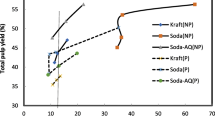Abstract
In this study, the response of Eucalyptus camaldulensis and Acacia mangium kraft pulp to different options of ECF bleaching was investigated. Oxygen-delignified pulps of both species having similar kappa number (c.a. 12) were used. Both the pulps were prebleached using conventional ClO2 stage (D0), combined use of ClO2 and O3 (DZ), hot acid treatment before D0 (AhotD0) and hot acid treatment before (DZ) i.e., Ahot(DZ), hot ClO2 treatment (DHT) and Ahot followed by DHT (AhotDHT). All prebleached pulps were finally bleached to 90%+ ISO brightness using D1 option. The overall benefits of other options were not considerable compared to D0 and (DZ). From the ClO2 consumption point of view, for a certain species, the option Ahot(DZ) was the best. Instead of D1 in final bleaching, pressurized hydrogen peroxide (PO) was also investigated in the case of D0 and (DZ) prebleached pulps. (PO)-bleached pulp produced higher brightness stability but lower viscosity compared to D1.






Similar content being viewed by others
References
Chirat C, Lachenal D, Angelier R, Viardin MT (1997) (DZ) and (ZD) bleaching: fundamentals and application. J Pulp Paper Sci 23(6):289–292
Costa MM, Colodette JL (2002) The effect of kraft pulp composition on its bleachability. In proceedings of international pulp bleaching conference, Portland, Oregon, TAPPI press, pp 195–213
Eiras KM, Colodette JL (2003) Eucalyptus kraft pulp bleaching with chlorine dioxide at high temperature. J Pulp Paper Sci 29(2):64–69
Eiras KM, Francis RC, Colodette JL, Lassel S (2005) The role of bound chlorine in the brightness reversion of bleached hardwood kraft pulp. In Proceedings of 2005 international pulp bleaching conference proceedings, Stockholm, SPCI, p 47
Fisher S, Corbeil S, Sunder M (1998) Strength preservation in ozone bleaching using (D/Z) or (Z/D) at low consistency. TAPPI pulping conference proceedings, Montreal, Quebec, TAPPI press, pp 1429–1444
Furtado FP, Evtuguin DV, Gomes TM (2001) Effect of the acid stage in ECF bleaching on Eucalyptus globulus kraft pulp bleachability and strength. Pulp Pap Canada 102(12):89
Gellerstedt G, Dahlman O (2003) Recent hypothesis for brightness reversion of hardwood pulps. Proceedings of international colloquium of eucalyptus kraft pulp, Vicosa, MG, Brazil
Gierer J (1982) The chemistry of delignification. Holzforschung 36(2):55
Helsinki University of Technology (HUT) (2002) Hexenuronic acid content of sulphate pulps. Work method C/6, Forest Products Department, Laboratory of Forest Product Chemistry
Jaaskelainen AS, Saariaho AM, Matousek P, Parker A, Towrie M, Vuorinen T (2003) Characterization of residual lignin structures by UV Raman spectroscopy and the possibilities of Raman spectroscopy in the visible region with Kerr-gated fluorescence rejection. Proceedings of 2003 ISWPC, Medison, WI, p 139
Karim MR, Malinen RO (2007) Suitability of the combined use of chlorine dioxide and ozone in prebleaching of Eucalyptus camaldulensis kraft pulp. APPITA J 60(3):228
Karim MR, Kolehmainen H, Malinen RO, Ruhanen M (2002) ECF bleaching of Eucalyptus camaldulensis kraft pulp with pressurized peroxide stage. Proceedings of 2nd international symposium on emerging technologies of pulp and papermaking (2nd ISETPP), Guangzhou, pp 402–409
Li J, Gellerstedt G (1997) The contribution to kappa number from Hexenuronic acid groups in pulp xylan. Carbohydr Res 302:213–218
Malinen RO, Zhao Hua-Ping (2005) Evaluation of the bleachability of Eucalyptus camaldulensis kraft pulp. International Pulp Bleaching Conference, Stockholm, SPCI, pp 188–193
Marechal A (1993) Acid extraction of the alkaline wood pulps (kraft or soda/AQ) before or during bleaching–Reason and opportunity. J of Wood Chem Tech 13(2):261–281
Mellander P, Dahl M, Norden S (2005) Hot D-bleaching of eucalyptus pulps—every pulp is unique. International pulp bleaching conference, Stockholm, SPCI, pp 25–30
Malinen RO, Nhan, DTT (2006) Control of hexenuronic acid content in bleached pulp and its effects on optical properties of pulp. Proceedings of 60th APPITA annual conference, Melbourne, Appita, pp 289–296
Ragnar M (2001) On the importance of the structural composition of pulp for the selectivity of ozone and chlorine dioxide bleaching. Nordic Pulp Pap Res J 16(1):72–79
Ragnar M (2004) On the theoretical basis for the low bleaching chemical requirement of hot chlorine dioxide bleaching of hardwood kraft pulp. Nordic Pulp Paper Res J 19(1):78–83
Ragnar M, Lindstrom ME (2004) A comparison of emerging technologies: hot chlorine dioxide bleaching versus hot acid treatment. Paperi Ja Puu 86(1):39–44
Ragnar R, Dahllof H, Lundgren S (2005) Towards environmentally sustainable bleaching of krft pulp. Evaluating the possible role of ozone. Appita J 58(6):475–480
Sevastyanova O, Li J, Gellerstedt G (2006) Influence of various oxidizable structures on the brightness stability of fully bleached chemical pulps. Nordic Pulp Paper Res J 21(1):49–53
Sundar M, Corbeil S, Homer G, Epiney M (2000) D/Z or Z/D low consistency retrofit. Pulp Pap Can 101(112):372–376
Suss HU, Schmidt K, Hopt B (2004) How to improve brightness stability of ECF bleached softwood and hardwood kraft pulp. Proceedings of 58th Appita annual conference, Australia, p 493
Tenkanen M, Forsskahl I, Tamminen T, Ranua M, Vourenvirta K, Poppius-Levlin K (2002) Heat induced brightness reversion of ECF-light bleached pine kraft pulp. Proceeding of 7th European workshop on lignocellulosic and pulp, p 107
Toven K, Gellerstedt G, Kleppe P, Moe S (2002) Use of chlorine dioxide and ozone in combination in prebleaching. J Pulp Paper Sci 28(9):305–310
Ventorim G, Collodette JL, Eiras KMM (2005) The fate of chlorine species during high temperature chlorine dioxide bleaching. Nordic Pulp Paper Res J 20(1):7–11
Vuorinen T, Fagerstrom P, Buchert J, Tenkanen M, Teleman A (1999) Selective hydrolysis of hexenuronic acid groups and its application in ECF and TCF bleaching of kraft pulp. J Pulp Paper Sci 25(5):155–162
Acknowledgments
The authors are grateful to the Government of Finland for the financial support of this research work. Also sincere thanks are due to Advance Agro (Thailand) and April (Indonesia) for providing industrial chips of Eucalyptus camaldulensis and Acacia mangium, respectively.
Author information
Authors and Affiliations
Corresponding author
Rights and permissions
About this article
Cite this article
Karim, M.R., Islam, M.N. & Malinen, R.O. Response of Eucalyptus camaldulensis and Acacia mangium kraft pulp in different ECF bleaching options. Wood Sci Technol 45, 473–485 (2011). https://doi.org/10.1007/s00226-010-0338-2
Received:
Published:
Issue Date:
DOI: https://doi.org/10.1007/s00226-010-0338-2




